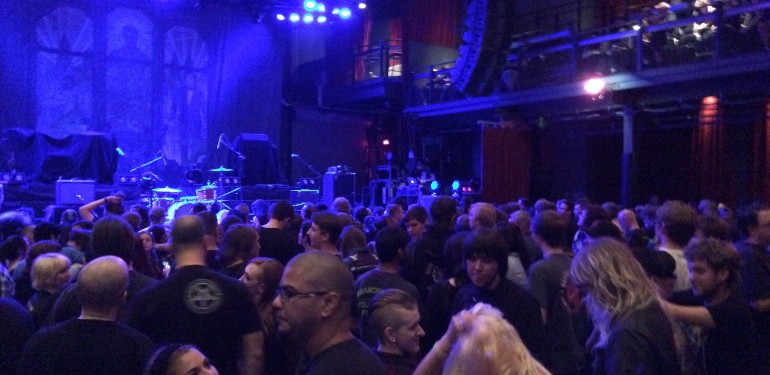Connor Smith and Jesse Harman, Staff Writers
Swedish doom metal band, Ghost, kicked off its “Black to the Future” U.S. tour at the Fillmore the same night Pope Francis touched ground for his American debut. The tour is an attempt to cultivate a more authentic, grassroots fanbase within the States. The band already holds superstar status in Sweden, having won numerous accolades and amassed staggering record sales, but thus far a foothold in the collective American heart has eluded Ghost.
The band consists of frontman Papa Emeritus III – a mitre-adorned anti-Pope plastered with exorbitant facepaint and flowing cloaks – and his unholy troupe of Nameless Ghouls. Although nameless, the Ghouls provide the skeletal backdrop for the Papa’s sermon.
The Ghouls — two guitarists, a drummer, a bassist and a keyboardist – sport no identifiers beyond their instruments. When they sign autographs, the band members’ represent their ‘names’ using unpronounceable alchemic symbols. On stage, their uniform is daunting and impressive: trim black robes and impossibly polished steel masks. Anonymity is key to the band’s overall aesthetic, and the performance preserves the visage of a sermon-like procession. The band’s presence only augments the image – although this comes at a cost of a truly authentic personality onstage.
The Ghouls initially appeared to be lifeless husks, obedient only to the whims of their instruments and to their Papa. Then the show progressed, and the cracks in their steely cold veil fissured. Some of the Ghouls would wander away from their onstage posts to engage each other in private stage banter. This sort of behavior is typical and expected of any ‘traditional’ musical outfit. But Ghost is a band that, as evidenced through its art and marketing, prides itself on its near-rigid formality and stoic uniformity.
This discrepancy began to tarnish the illusion of us witnessing a sermon or attending a service – we became aware of Ghost’s inconsistent execution of its concept. Along with Matt Dotson at WGMU, we conducted an interview with one of the Nameless Ghouls. Our impression of Ghost became even more muddled as we continued to carve out a definitively human character behind the masks.
“The concept of linear religion … trying to control our lives is definitely contemporary,” said the Nameless Ghoul. “So we knew that in order to make a point, we cannot stay within that cemetery, spider-webby sort of world [typical of the doom metal genre].” The Ghoul further elaborated, stressing that the challenge with Ghost is finding a way to express a change while maintaining their core identity.
And for all the inconsistencies and shaky grounds of the band’s aesthetics we’ve noted, Ghost truly is a compelling entertainment act. The Ghouls’ aural lockstep – almost exact to the recordings in every detail, upon further inspection – was awe-inspiring. These are musicians who truly feel a connection to the music they produce, masks and makeup aside. Papa Emeritus guided us through his procession with the theatrics of someone who might have only read descriptions of Catholic Masses, but solemnly trusted his own understanding. The Ghouls surged through tracks with their muted excitement.
Unfortunately, as the show raged on, the visuals veered towards repetition and redundancy. Ghost advertises itself as a band that prides itself on its originality and unique stage show. The permeating incense and stage decorations initially delivered on this promise, but the effect soon grew stale. The shifting colors in the lightshow began as a means to visually parallel the musical thematic and tone changes; as time went on, the effect grew monotonous and uninspired. The backing vocals – played over the sound speakers in a pre-recorded track – overpowered Papa’s live voice at many intervals, loosening our anti-Pope’s firm authority over the stage and crowd. These not-so-insignificant missteps made what could have been a truly exhilarating spectacle into an above-average showcase of talent.
The greatest hurdle imaginable for Ghost is recruiting new followers into its fold. Hardline fans at this sold-out and packed show pulled out all the stops in support of their beloved Papa and Ghouls. The overall impression from individuals outside of that hardline demographic, however, seems a tad underwhelmed.
“I think their theatrics were pretty on point,” said Mason student Greg Muckey, winner of WGMU’s Twitter-based ticket giveaway. “The look was good, with the masks and everything.”
Contest winner Maddie Lavallee agreed. “I think the musicians were good, it was just alright overall,” she said.
When we asked both Muckey and Lavallee if they would ever hope to see Ghost again, their answer was a resounding and decisive “no.” That alone speaks volumes of the band’s overall impression on new listeners and non-fans.
In its entirety Ghost seemed like a band apart from itself. Though staging and costumes were incredible, musicians couldn’t seem to take the mantle of shock to the next level. Hiding behind a mask can lead to wonderful things: to award winning novels about musketeers, to paying a costume designer’s rent, and even to inspiring a sense of mystery. What a mask cannot do is express love or pain. A mask cannot be charismatic. A mask cannot retain its continuity or a personality. Ghost is great at what they do. They take a solid, but unremarkable sound and drape it in fineries, while hiding behind masks to retain their personal lives or remain anonymous to hecklers. Whichever is the case, it was a fun show, and we wish them the best of luck in America.
Smith and Harman participated in our first collaboration with WGMU for their interview with the band. Here is the link for Smith, Harman, Matt Dotson and WGMU’s live interview with Ghost: http://wgmuradio.com/2015/09/21/ghost-interview-with-a-nameless-ghoul-part-1/






